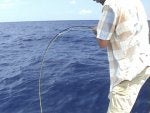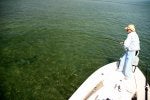Once the first guide has gathered the line, what function do the 2nd and 3rd stripping guides perform except to degrade the rod action? Perhaps if the first guide is huge, the second and third serve to further gather the line? You have to see if that function could be performed by tapering snake guides.
In my opinion, additional stripping guides add unnecessary mass and cost. The 2nd and 3rd stripping guides will stiffen that area of the rod sections and hinder the rod action.
Maybe I am wrong and on high line wt rods; maybe additional stripping guides make up for the added mass by increasing castability???? 2 stripping guides used to be relatively common even on some trout rods.
The lower rod action can hardly be degraded by ceramic insert guides in 11 wt and larger rods rods considering the weight of the blank, the line and the reel. They are there for friction reduction when fighting fish on a very bent rod, especially in warm climates in salt water where the lines are soft from the heat and sticky from partially recrystallized salt water.
Look at the two photos below and you'll notice that the line forms a distinct angle at each guide of the first few guides until it gets up the rod length where that angle becomes so obtuse as to be almost in a straight line with the snake guides because the rod is far more flexible up there.
Remember that just because the line goes from 4" on the reel down to the stripping guide, it does not continue in a straight line to the next one because the rod is bent. So there is a lot of friction on that second and also the third guide as well.
The difference between a 5 wt rod design and a 12 wt design is about the same as between a Ford Taurus and a Peter Built.
A couple pics to illustrate what I'm talking about.
You can see how linear the line is compared to the rod bend even though the guy is retrieving line because the reel is off the rod blank plane. Unfortunately the second guide is out of the frame.

The one below shows enough guides to illustrate my point. You'll notice that it has only two ceramic guides, not three.
Yet you will also notice that there is a very distinct angle formed by the line on that third (snake) guide. Yet all the remaining guides are almost parallel to the rod because it is bent nearly straight down.
You may also notice that the guy's shirt is unbuttoned because it is so hot and still. The line coating is very soft despite the solid hard monocore it is formed onto.
In my view, under those conditions a ceramic guide would have been very beneficial.

Some beautiful music from the picture above.
[video]http://www.miterclamp.com/videos/beautiful_music.mp4[/video]



